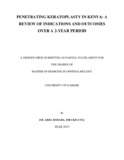| dc.contributor.author | Hydara, Abba | |
| dc.date.accessioned | 2013-11-12T11:42:27Z | |
| dc.date.available | 2013-11-12T11:42:27Z | |
| dc.date.issued | 2013 | |
| dc.identifier.citation | Master Of Medicine In Ophthalmology | en |
| dc.identifier.uri | http://erepository.uonbi.ac.ke:8080/xmlui/handle/11295/58689 | |
| dc.description.abstract | Introduction: Acquired corneal blindness is the third leading cause of visual loss globally. The greatest proportion of the blindness is either preventable or treatable; most of those due to corneal diseases are amenable to successful prevention or treatment. Penetrating keratoplasty can alleviate selected cases of corneal blindness and is one of the most successful and most frequently performed solid organ transplants world-wide. However, not many centres offer penetrating keratoplasty in Africa; those that do depend on modest amounts of donor corneas from overseas.
Aim: To document the indications for and outcomes of penetrating keratoplasty in Kenya over a
2-year period.
Methods: A retrospective case series of 174 eligible penetrating keratoplasties performed in 6 different facilities in Kenya from January 2001 to December 2011 was undertaken. Univariate and multivariate analyses were done. Corneal graft survival probabilities were determined using the Kaplan-Meier method.
Results: Keratoconus was the commonest indication accounting for 48.8% followed by bullous keratopathy at 18.4%.Pre-operatively, 66.7% of the eyes were blind with visual acuities
<3/60.Corneal epithelial defect (43.5%) was the commonest early complication followed by corneal oedema (25.2%); persistent corneal oedema was the commonest late postoperative complication. At 24 months, 82.2% of the grafts remained clear while 17.8% (n=31) were not clear; only 8.24% of keratoconus grafts failed while 26.97% from other indications failed (relative risk=3.2745, [95% CI 1.4895-7.1986], p<0.0012).Postoperatively, 71.82% of all grafts had final uncorrected vision of 6/60 or better, while 16.67% of grafts remained blind. Thirty-one (17.82%) grafts failed, of which 25.8% were due to primary graft failure and 74.2% were due to secondary graft failure. Survival probabilities at 24 months showed 90% of keratoconus grafts survived while 68% for the other indications survived with p< 0.0068. Poor predictors of corneal graft outcome were: bullous keratopathy (p<0.0019), postoperative glaucoma (p<0.0023), infection (p<0.0001), and persistent corneal oedema (p<0.0001).
Conclusions: Keratoconus remains the leading indication for corneal grafts in Kenya and grafts provide meaningful vision for the commonest indications. Corneal graft survival has improved,
especially for corneal dystrophies and keratoconus. These findings are similar to results in industrialised countries. Poor predictors of graft outcome were corneal ulcers, herpes simplex keratitis, corneal graft glaucoma, and corneal graft oedema. Contemporary causes of corneal blindness in Africa such as vitamin A deficiency and trachomatous corneal blindness were not encountered and may be receding in importance. Our findings suggest most corneal grafts in this part of Africa could attain longer graft survivals as well as better visual outcomes. | en |
| dc.language.iso | en | en |
| dc.publisher | University of Nairobi | en |
| dc.subject | Penetrating Keratoplasty, Indications, Visual Outcome, Survival, Risk Factors, Poor Predictors | en |
| dc.title | Penetrating keratoplasty in Kenya: a review of indications and outcomes over a 2-year period | en |
| dc.type | Thesis | en |
| dc.description.department | a
Department of Psychiatry, University of Nairobi, ; bDepartment of Mental Health, School of Medicine,
Moi University, Eldoret, Kenya | |
| local.publisher | School of Medicine | en |

